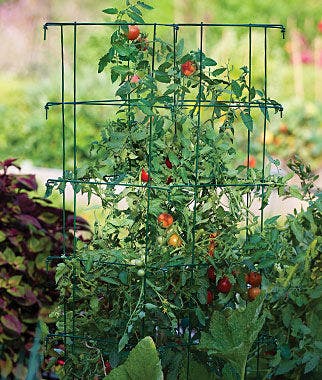We use cookies to give you the best experience on our website. These cookies are completely safe and secure and will never contain any sensitive information. Please read our Privacy Policy. By clicking "Ok" or clicking on any other content, you agree that cookies can be placed.
Tomatoes Cages
Tomato cages sound a little cruel, but they are the best thing you can do for tomato plants. Growing tomatoes inside sturdy wire cages increases yield and is less work for the gardener.
Tomato plants are simply not strong enough to stand up on their own. Once they're up and growing, they have a tendency to sprawl on the ground, taking up precious space in garden beds. Surrounding each plant with a cage provides support, keeps them from being stepped on or bruised when you're working in the garden, and helps protect the fruit from sunburn.
"When they grow on the ground, everything is a tangled-up mess," says James Worley, a tomato gardener in Kansas City who grows dozens of different kinds of tomatoes every year and blogs about it. Caged tomatoes are much easier to take care of, he says: "I get better production and have fewer diseases."
Tomato plants naturally tend to branch out or sucker as they grow. When you support plants with stakes, pinching or pruning out the suckers (which develop between the main stem and the leaf) limits the plant's growth to a single stem. The stem has to be tied to the stake every 10 or 12 inches to prevent it from breaking when it becomes heavy with fruit. In cages, the suckers are not a liability: as they grow, they fill out the cage, actually supporting the plant and shading the fruit from the sun (and from the birds). Because the growth along these side stems also blooms and produces fruit, you'll harvest more tomatoes from tomato plants in cages than from plants tied to stakes. The fruit may be a little bit smaller, but an abundant harvest makes up for it.
Gardeners interested in good pollination also have a reason to grow tomatoes in cages. Worley increases his yield by rattling his tomato cages. "I just shake the cages a little bit to encourage pollination," he says. "When you see blooms, give the cage a vigorous shake."
Tall, sturdy cages are essential. Indeterminate tomato varieties (such as 'Big Boy' and 'Fourth of July') are the kind that keep growing and produce fruit all summer long, rather than in one grand flush, can grow to six feet tall during the season, and a cage that is too short or not strong enough only works while the plants are small. Good cages support tomato plants all summer long, without pruning or tying, and last for years. A wise investment in tomato cages repays itself quickly.

